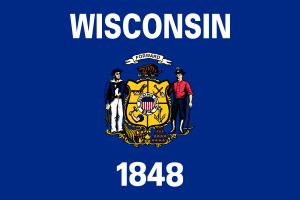2nd Wisconsin Volunteer Infantry Regiment
The 2nd Regiment Wisconsin Volunteer Infantry was an infantry regiment that served in the Union Army during the American Civil War. It spent most of the war as a member of the famous Iron Brigade of the Army of the Potomac.
| 2nd Regiment Wisconsin Volunteer Infantry | |
|---|---|
 Wisconsin flag | |
| Active | June 11, 1861, to July 2, 1864 |
| Country | United States |
| Allegiance | Union |
| Branch | Infantry |
| Engagements | Battle of First Bull Run Battle of Groveton Battle of Second Bull Run Battle of Chantilly Battle of South Mountain Battle of Antietam Battle of Fredericksburg Battle of Chancellorsville Battle of Gettysburg Battle of the Wilderness Battle of Spotsylvania Court House |
Service
The Governor of Wisconsin, Alexander W. Randall (R), issued a call to arms throughout the state of Wisconsin following President Abraham Lincoln's April 15, 1861, proclamation for troops to put down the rebellion. Enough Wisconsin men enrolled to allow the formation of two regiments, one more than the single regiment quota from Lincoln's directive. The 2nd Wisconsin was primarily raised in Madison, Racine, Milwaukee, Oshkosh, and La Crosse. It assembled in Madison and was mustered into Federal service on June 11, 1861, as a three years regiment (reorganized from the original three months regiment).[1] Governor Randall commissioned S. Park Coon, a 41-year-old native of New York and Wisconsin's attorney general prior to the war, as the new regiment's first colonel. The lieutenant colonel, Henry W. Peck, was an Ohioan who had graduated from West Point in 1851 and provided some professional military experience and training, versus the political appointee Coon.[2]
The regiment was transported to Washington, D.C., and saw its first combat at the First Battle of Bull Run in July 1861 in a brigade under William T. Sherman. Due to some of the men were state militia grey uniforms, the 2nd Wisconsin received some friendly fire from Union troops mistaking them for Confederates. Coon, never comfortable in his role as a military man, resigned July 30 to return to politics. Peck and the major also resigned, all were considered victims of the regiment's poor performance at Bull Run.[3] Three new field officers replaced them—Col. Edgar O'Connor, Lt. Col. Fairchild, and Maj. Thomas S. Allen. The appointment of O'Connor, married to a Southern woman and an outspoken Democrat, was met with sharp criticism in Wisconsin's media, particularly in the Republican newspapers. He would prove to be a brave and competent leader, however, and was killed in action in Virginia in late summer 1862.[4] Lt. Col. Fairchild was promoted to the rank of full colonel on September 8, 1862, to become the third commander of the 2nd Wisconsin Volunteers.
The regiment suffered severe casualties during the 1862 Northern Virginia Campaign, fighting against Stonewall Jackson's Confederates at the Battle of Groveton, and seeing more action at the Second Battle of Bull Run. During the subsequent Maryland Campaign, the 2nd Wisconsin attacked Turner's Gap during the Battle of South Mountain, and then again took high casualties in the Cornfield at Antietam.
Perhaps the regiment's finest hour came at Gettysburg, where it lost 77% of its strength (233 casualties out of 302 effectives) in stubborn fighting on McPherson's Ridge during the Iron Brigade's lengthy action on July 1, 1863.[5] Colonel Fairchild lost an arm due to severe wound, and most of the line officers went down as well. The regiment reformed on Culp's Hill and entrenched for the rest of the battle. It later served in the Bristoe and Mine Run Campaigns.
Although the 2nd Wisconsin was able to replenish some of its losses, it was never the same fighting force again. The regiment was mustered out on July 2, 1864. New recruits and later enlistees were consolidated into a battalion which was amalgamated with the 6th Wisconsin Volunteer Infantry Regiment on November 30, 1864.
Total enlistments and casualties
The 2nd Wisconsin Infantry initially mustered 1051 men and later recruited an additional 152 men, for a total of 1203 men.[6] The regiment lost 10 officers and 228 enlisted men killed in action or who later died of their wounds, plus another 77 enlisted men who died of disease, for a total of 315 fatalities.[7]
Colonels
- Colonel S. Park Coon - April 24, 1861, to July 30, 1861 - Resigned.
- Colonel Edgar O'Connor - August 3, 1861, to August 28, 1862 - Killed in action at Gainesville, Virginia, during the Second Battle of Bull Run.
- Colonel Lucius Fairchild - September 8, 1862, to October 20, 1863 - Promoted to brigadier general by President Lincoln.
- Colonel John Mansfield - February 9, 1864, to August 14, 1864 - Mustered out with the regiment[8]
References
- The Civil War Archive
- Busey, John W., and Martin, David G., Regimental Strengths and Losses at Gettysburg, Highstown, New Jersey: Longstreet House, 1994. ISBN 0-944413-32-3.
- Nolan, Alan T., The Iron Brigade: A Military History, Bloomington, Indiana: Indiana University Press, 1994. ISBN 0-253-20863-7.
Notes
- Nolan, page 4.
- Nolan, page 5.
- Nolan, page 10.
- Nolan, page 11.
- Busey & Martin, page 239.
- 2nd Wisconsin Archived March 26, 2007, at the Wayback Machine
- Civil War Archive
- Nolan, page 287.
External links
- Second Wisconsin Volunteer Infantry - A large website with comprehensive information on the 2nd Wisconsin, as well as many other Wisconsin-based Civil War regiments and civilian life in the state during the period.
- Wisconsin Battle Flags- A website by the Wisconsin Veterans Museum Foundation showcasing the battle flags of Wisconsin regiments, including the 2nd Wisconsin.